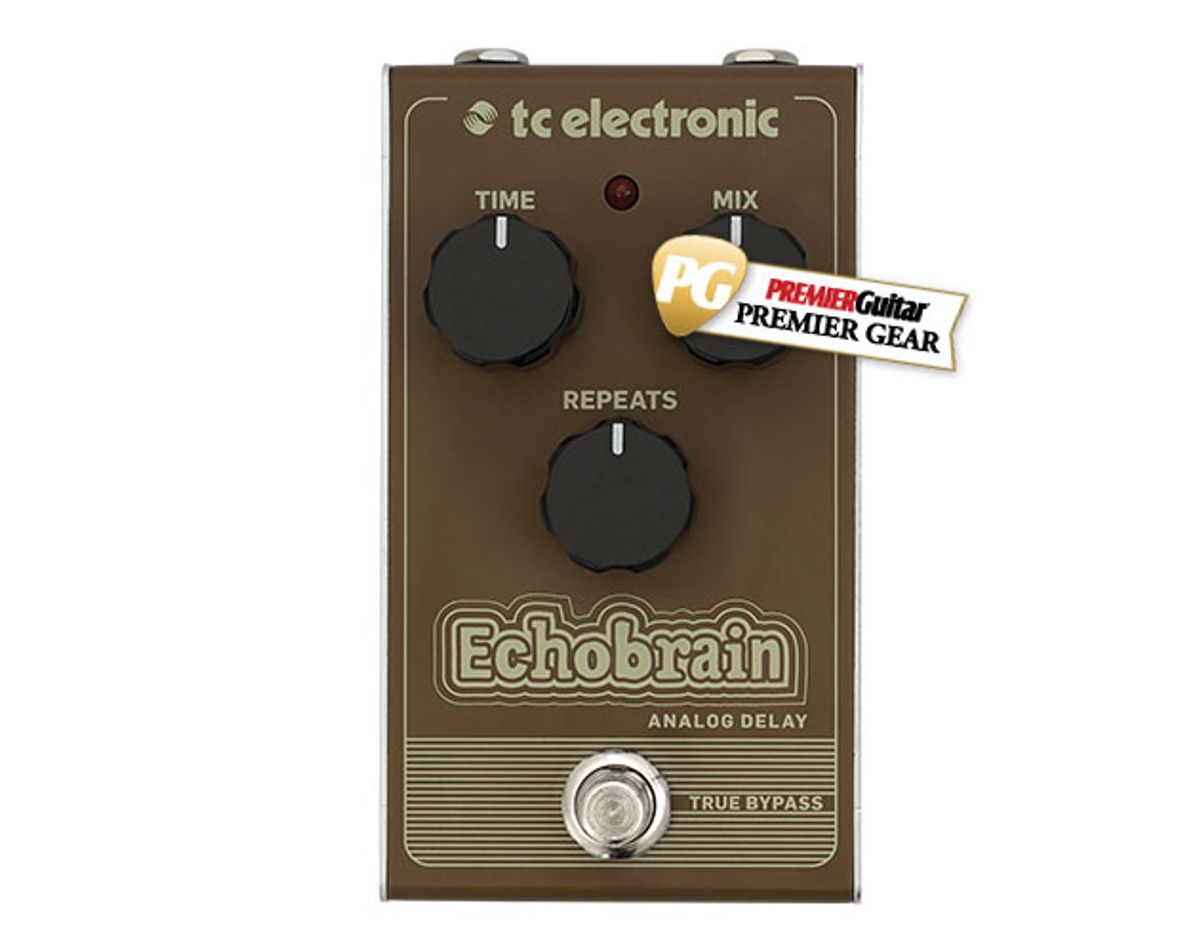
A fantastically colorful and expressive bucket brigade analog delay at a ridiculously low price.
Curiously, TC Electronic never gave a name to the line of affordable, metal-enclosure stompboxes they announced late last year. That leaves it to the stompbox nerd community to contribute a label. And given how many of these pedals seem like budget classics in the making, we suspect a new handle—and a cult following—is fast forthcoming.
The Echobrain analog bucket brigade delay has a memorable enough name. But it’s the resonant, colorful, and occasionally haunting lo-fi sounds it produces and its sensitive, tactile control set that make using it so addictive.
Echo Regeneration Redux
In the wake of Behringer’s purchase of TC Electronic, it’s quite likely the Echobrain is an improvement and update of the Behringer VD400 (Behringer designs are the heart of many new, affordable TC pedals). But the improvements are significant, and the upgrades to the controls and pots are enough to make this an altogether different and much more musical pedal.
The metal enclosure is robust and attractive with more than a hint of ’60s transistor radio influence in the design. Some will lament the relatively large enclosure, but it probably facilitates use of the single PCB used to mount all the components, jacks, pots, and the footswitch. The enclosure seems sturdy enough that the board mounted jacks and pots won’t be a problem. But the footswitch is of the type that activates the effect upon release, creating mechanical latency when you switch the effect on. Replacing the switch should be an easy mod, but mounting the switch on the board makes the procedure tricky to impossible. The upside? The manufacturing costs saved by the process are a huge part of the rock bottom price.
Ratings
Pros:
Insanely low price. Expressive control set. Sensitive, rangeful pots. Great repeat tones.
Cons:
Footswitch activates on release, which creates mechanical latency at bypass.
Tones:
Ease of Use:
Build/Design:
Value:
Street:
$59
TC Electronic Echobrain
tcelectronic.com
Tasty Time Tinkering
Echobrain’s controls have great range and sensitivity, which enables very precise delay times, repeat rates, and mix levels. Better still, the large knobs and firm but smooth resistance of the pots enable and encourage highly expressive interactions. Mix swells have a smooth curve, and the tactile sensitivity and control over repeat rates and delay times are superb. That means you can creatively ride the feedback and resonant peaks that occur at the verge of self-oscillation, perform radical or gentle accelerations and decelerations of repeat rates, or create terrifying echo swells. Few contemporary delays are as fun to use for these creative effects (the Ibanez Echo Shifter is one exception), and the Echobrain can rival classics like the Deluxe Memory Man and Echoplex in terms of hands-on musical malleability.
At the fastest repeat settings, Echobrain twitches at hummingbird heart rates, and as you move through these speedy echo rates you can hear traces of ring modulation, ADT, and tile reverb. Some of the repeats are close enough to create a sort of phase cancellation—achieving a cool EQ filtering effect not miles away from a cocked wah. As the output veers gradually toward oscillation, cool metallic high-mid overtones appear prominently in the repeats, evoking spring reverb and some of the clanging tones of oil can delays, without the modulation.
Though most pronounced at high repeat rates and mix levels, those overtones are a fundamental part of the pedal’s voice. And they lend transportive vintage color to the slapback-style repeats, which occur with the time knob between 9 o’clock and noon. (I won’t be surprised if Echobrain becomes standard issue for the lead-sled-and-Gretsch set, in time).
Longer echoes (with a 300 millisecond ceiling, they only get so long) have just as much color and provide ample space for early Pink Floyd sojourns, lo-fi psychedelic trips, deep dub skanking, and Joe Meek sci-fi textures.
As colorful as Echobrain can be, the high-end content in the repeats can be tricky with fuzz or the wrong amp. I might be hesitant, for instance, to tinker with Echobrain’s most resonant tones with a Tone Bender Mk II and Twin Reverb on either side. (Actually I wasn’t hesitant to try this formula at all, but it was hairy business!)
The Verdict
Echobrain is just about the most fun you can have for 60 bucks. The footswitch is annoying, but that shortcoming is offset by a superb and sensitive control set, and echo tones that you may never want to play without for certain songs. Echobrain can enliven the dreariest guitar and amp tones. (In fact, it sounds especially amazing with cheap, solid-state rigs, if you have such lo-fi proclivities.) I could even see using this pedal at a mixing desk for adding bold vintage colors and performing radical effects during a mix. Indeed, Echobrain is everything that’s great about analog delay at a price you almost can’t refuse.



